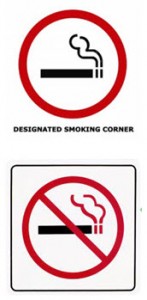Smoking and overall tobacco use is on the decline in the U.S., but enough adults still smoke that your business should have a policy addressing this issue. Find out below the two types of state laws that regulate workplace smoking and the three most common smoking policies employers implement.
According to recent data from the Centers for Disease Control (from 2009), over 20% of the U.S. adult population smokes. Although the percentage of smokers has declined steadily since 1965 (when 42% of the adult population smoked), the fact remains that one-fifth of adults still smoke, so you need to address this issue in your organization’s workplace policies.

First Consideration: State and Local Laws Restricting (and Protecting) Smoking
When drafting a workplace smoking policy, you first should consider any state or local restrictions protecting the rights of nonsmokers and smokers. (Federal law does not address smoking in the workplace except in government workplaces.) A majority of states have passed laws restricting or limiting smoking in workplaces or public places, a term that typically includes private workplaces. While some states try to balance smokers and nonsmokers rights by allowing employers to designate smoking areas, the trend in state regulations is to ban smoking entirely, even in private workplaces. At least twenty-one states (including Arizona, California, Colorado, Hawaii, Illinois, Maryland, Massachusetts, Michigan, Montana, New Jersey, New York, Ohio, Pennsylvania, and Washington) and the District of Columbia have banned smoking in nearly every workplace, including bars and restaurants. In addition to state laws, you may have to comply with local ordinances, which often are more restrictive and impose greater fines.
You also should be aware of smokers rights laws in over half of the states that may limit your ability to prohibit off-duty smoking, including in Connecticut, the District of Columbia, Indiana, Kentucky, Louisiana, Maine, Mississippi, New Hampshire, New Jersey, New Mexico, Oklahoma, Oregon, Rhode Island, South Carolina, South Dakota, Tennessee, Virginia, West Virginia, and Wyoming. These laws prohibit employers from taking any adverse employment action against employees or job applicants who smoke away from the employer’s premises during nonworking hours. These laws typically prevent employers from hiring only nonsmokers or from disciplining or terminating employees solely because they smoke. Accordingly, you should check state law before implementing any smoking ban that goes beyond the workplace.
Three Options for Smoking Policies
You have several options for a workplace smoking policy, each with advantages and disadvantages. When developing a smoking policy, you should consider the following issues: any state or local regulations governing smoking in the workplace (see above); any union contract provisions requiring the employer to bargain over smoking policies; any state laws protecting smokers from discrimination for off-duty smoking (see above); what policy provisions will protect both employees and the work environment; how the policy will be enforced; and disciplinary action for employee noncompliance. Employers commonly adopt one of three types of smoking policies: restricted indoor smoking, smoke-free building, or smoke-free workplace.
Restricted indoor smoking.
Some employers try to accommodate both their smokers and nonsmokers by allowing smoking only in specific areas. These employers typically designate certain areas as nonsmoking (such as open or common areas) and allow smoking in other areas (such as private offices and meeting rooms). Some employers restrict smoking to specially ventilated smoking lounges. Most employers restrict smoking to rest and meal breaks. In addition, employees who do not have private offices typically must smoke in designated areas away from their workstations.
Even so, nonsmoking employees may complain about secondhand smoke if the smoking lounge is near work areas or not adequately ventilated. Further, frequent employee visits to the lounge can distract and annoy nonsmoking workers. Finally, employers may have to comply with specific requirements imposed under state or local law related to ventilation, location, and physical barriers for designated smoking areas.
Smoke-free building
An increasing number of employers have adopted the “smoke-free building” approach which allows smoking only outside the building during rest and meal breaks. This approach eliminates concerns about the adequacy of the ventilation system and the need to reconfigure workspace.
However, smokers may complain about being relegated to the outdoors in bad weather, while nonsmokers may resent passing through smokers’ litter and smoke to get to the building. To address these complaints, some organizations construct an outside smoking shelter away from building entrances and make smokers responsible for the cleanliness of these areas. (The Model Policy Comment (2) can be revised easily to ban indoor smoking by stating “Smoking is prohibited inside all Company facilities.”)
Smoke-free workplace
Another approach bans all smoking from the workplace, including outside the building and in employee cars. This approach eliminates the litter and break abuses but may cause qualified applicants and employees who smoke to look for work elsewhere. (The Model Policy Comment (2) can be easily revised to ban indoor smoking by stating “Smoking is prohibited both inside and outside all Company facilities.”)
A few organizations have taken the very restrictive approach of prohibiting employees from smoking even off of the employers’ premises and during personal time. These restrictions on smoking away from work have prompted the passage of state “smokers’ rights” laws and thus are unlawful in several states (see above).
Of these three options, many employers favor the second one, the smoke-free building policy. First, it balances the needs of both smokers and nonsmokers. In addition, it eliminates secondhand smoke in the workplace and, therefore, may reduce the employer’s potential liability to nonsmokers. Further, the employer does not have to make any expensive interior structural renovations to accommodate an indoor smoking lounge.
This article is from the HR Matters E-Tips provided by Personnel Policy Services, Inc., 159 St. Matthews Ave., Suite 5, Louisville, KY 40207. Download a free Smoking model policy including HR best practices and legal background by signing up for a free access account.
Do you have employee’s who smoke? How are you handling a company smoking policy?